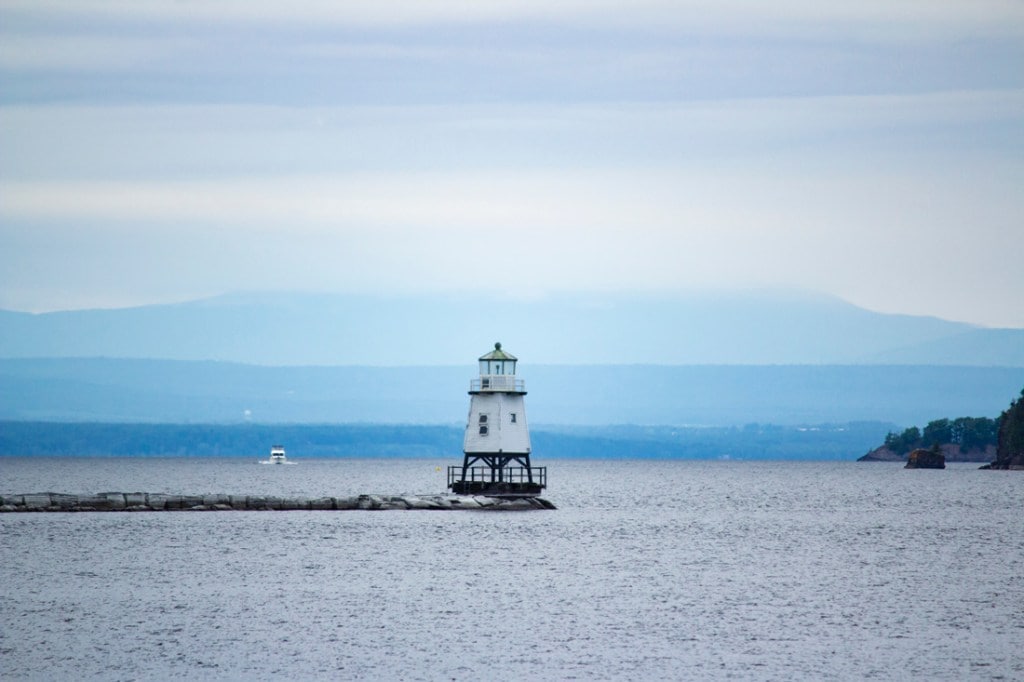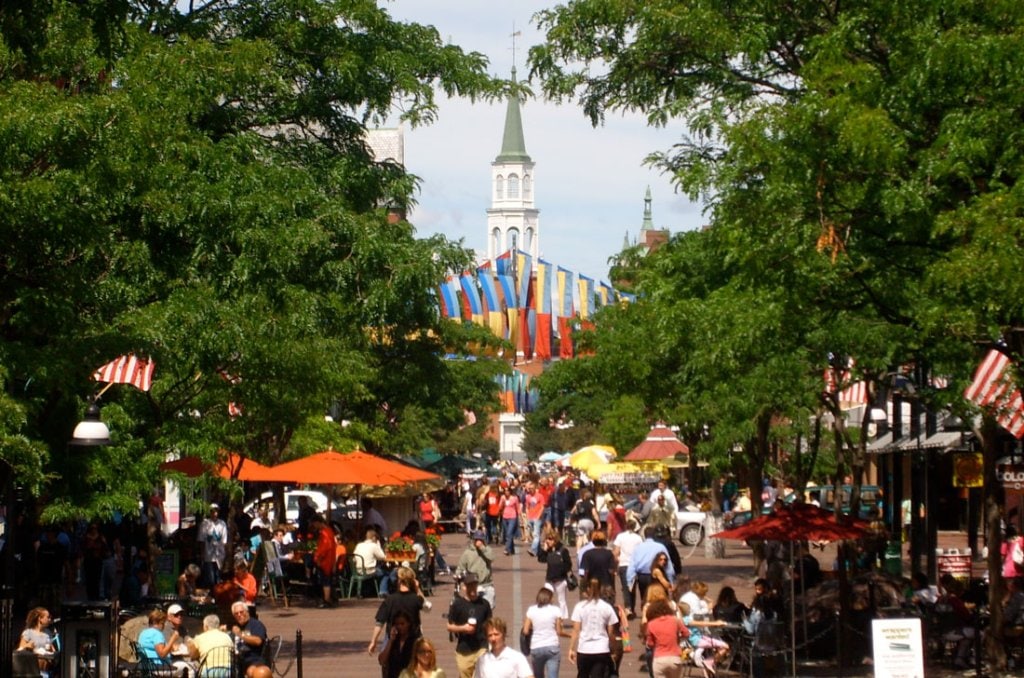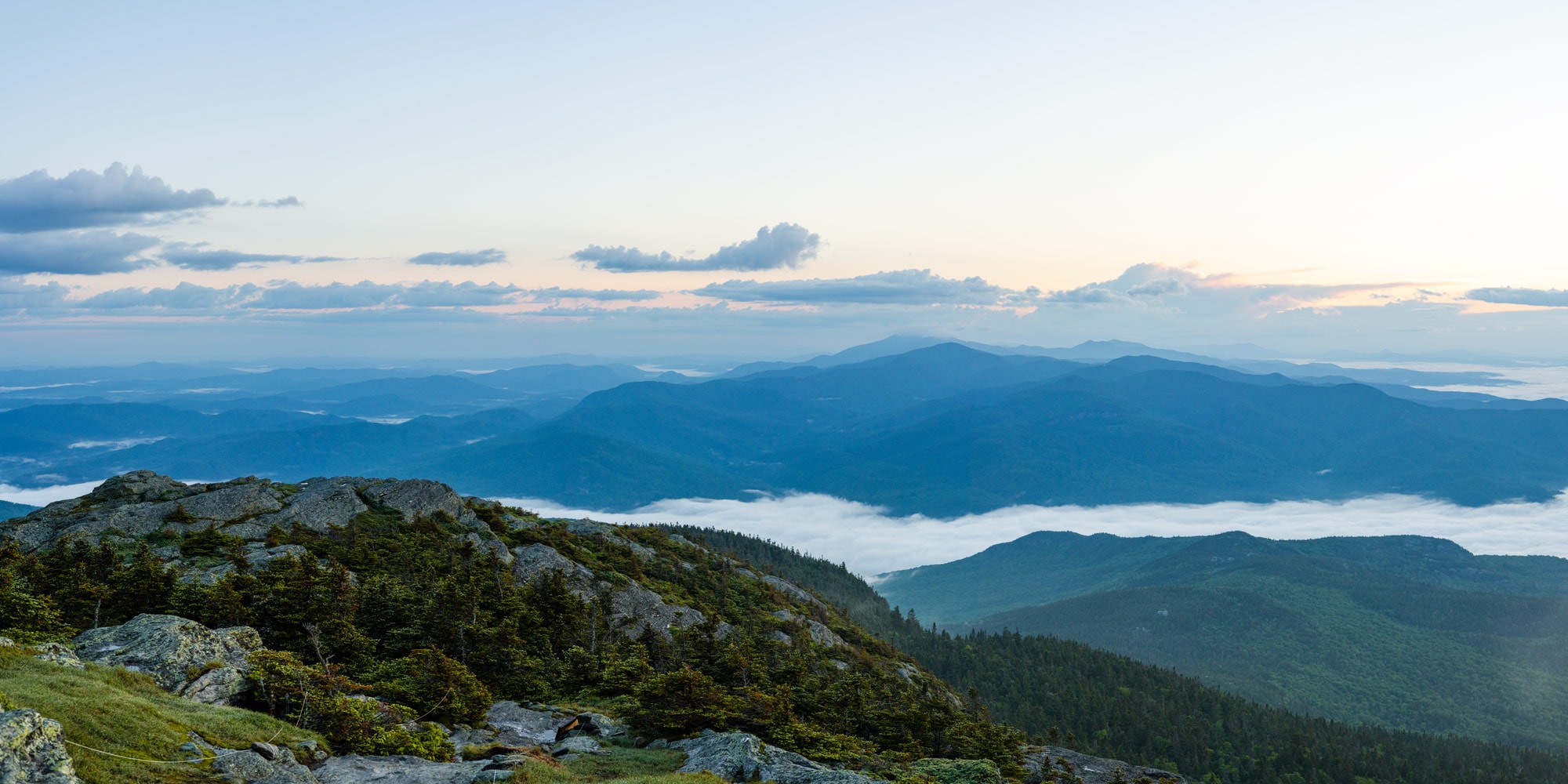Vermont isn’t exactly known for its city life. The tiny state is much more famous for its year-round adventures: Ski hills dot the mountains, peaks beg to be bagged, miles of trail are ripe for riding, secret crags hide in the forests and giant lakes hold plenty of paddling (and mysterious sea monsters). There’s so much to do you won’t miss the hustle and bustle of city life. But if you do, Burlington—the state’s unquestioned adventure hub—is chock-full of amenities and excitement from places like Flynn Theater, home of the Vermont Symphony Orchestra, to the pedestrian-only Church Street Marketplace to Ben and Jerry’s iconic scoop shops.
1. Summit Camel’s Hump
With New York’s Adirondacks just across Lake Champlain to the west and New Hampshire’s White Mountains towering to the east, it’s easy to forget about Vermont’s Green Mountains. They aren’t quite as tall as the White’s Mount Washington (nor do they feature its famously wicked weather) and don’t have an iconic peak-bagging bucket list like New York’s 46er peaks, but that hardly matters. One of the best introductions to the region is just an hour east of Burlington. This 5.5-mile loop hike over Camel’s Hump, the state’s third-tallest mountain, winds through verdant forests to a rocky, 4,085-foot summit covered in delicate alpine tundra. The views span from spine-like ridges of the Greens all the way to the Adirondacks and Whites in the distance, all without the kinds of crowds you’d find in the neighboring ranges.
2. Backpack the Long Trail
The north-to-south direction of the Greens also creates a perfect, natural corridor for mountain travel, something the locals took note of as early as 1910. That year, work began on the Long Trail, the oldest long-distance hiking route in the U.S. (and the inspiration for the much longer and more famous Appalachian Trail). The 272-mile footpath bisects the state from the southern border with Massachusetts clear to Canada, crossing not only Vermont’s highest peaks (including Camel’s Hump), but threading together its lowlands, hardwood forests, lakes, ponds and deep wilderness. The route can take a month to complete, but the weekend-ready, 22.2-mile section between Bolton and Mount Mansfield will give you a taste of what makes the trail so special. Follow the ridge north, climbing slowly to camp at the Puffer Lean-to below Mount Mayo. You’ll finish the trek the next day atop 4,293-foot Mount Mansfield, the state’s highest point.
3. Ride the Lifts at Mad River Glen
Spend enough time in Burlington, and you’re bound to be taunted by “Ski It If You Can” bumper stickers branded with the name of a single resort: Mad River Glen. The small, co-op-owned ski area 35 miles southeast of the capital in Waitsfield is a cult classic with a reputation for being New England skiing the way it used to be. With no snow making and limited grooming, the mountain relies completely on the elements. It even has one of only two single-chair lifts still operating in the country. So while there’s plenty of beginner-friendly runs, Mad River’s legendary tree skiing, whimsical conditions and steeper, backcountry-like terrain lend more than enough credence to those bumper stickers to make them a point of local pride.
4. Ski Tour the Bolton Valley Backcountry
Even with its old-school vibes, Mad River Glen is still lift-served, so if you’re interested in earning your turns, make the half-hour drive to Bolton Valley Ski Resort instead. Over the last decade, locals have worked hard to preserve roughly 1,500 acres of backcountry terrain next to the resort, a patch of land that includes everything from cross-country trails to easy tree runs to challenging steeps. Stop by the Bolton Valley Nordic Center for a pass, then climb to Paradise Pass before skiing into the Cottonbrook Drainage, which holds some of the best snow. New to the sport? Consider taking an intro to backcountry skiing class at REI’s Williston store.
5. Mountain Bike the Kingdom Trails
Packed with nearly 100 miles of technical singletrack, sculpted flow trails, skills parks, pump tracks and mellow forest roads, northeastern Vermont’s Kingdom Trails are well worth the $15 day pass and two-hour drive from Burlington. You can check out our guide to shredding the trail system in a single weekend here, but for a good introduction, hop on the Mountainside Loop. Beginning and ending at the Burke Mountain Campground, the 16-mile lap links the J-Bar and Moose Alley trails for flowy downhill, roots, jumps and bridges through the dense New England woods.
If you’re hoping for something closer to Burlington, the Sunny Hollow Nature Area, just a short drive from downtown, features a smaller but diverse collection of trails.
6. Hunt for Champ on Lake Champlain

A lighthouse on Lake Champlain near Burlington, Vermont. (Photo Credit: Gautam Krishnan on Unsplash.)
Vermont’s Lake Champlain is unique among New England’s paddling hot spots for one compelling reason: It comes with the chance to spy a cryptozoological marvel. Champ is supposedly a “20-foot serpent, thick as a barrel” with a “head like a horse” that purportedly roams Lake Champlain. To date, there have been more than 300 reported sightings, but the existence of the sea, er … lake monster has never been confirmed. Toss your kayak or SUP in the water at North Beach Park, just north of downtown. From there, it’s a quick paddle to Lone Rock Point, a thrust fault born of the same origins that formed the Green Mountains on the other side of town. That way, even if you don’t spot Champ, you’ll still have plenty of interesting views.
7. Explore the Island Line Trail
The water isn’t the only way to explore Burlington’s shoreline. The 13.9-mile, paved and crushed-stone Island Line Trail travels from Oakledge Park along the lake on a former railroad bed. An end-to-end trek can be done as a long hike or quicker ride and features views of the city and the Adirondack Mountains across the lake. The trail travels along a narrow causeway over the water and finishes with a 200-foot ferry ride to reach South Hero, a small town on Grand Isle, the lake’s largest island.
8. Rock Climb in Bolton
A straight shot 30 minutes out I-89 from Burlington plops you right in the middle of some of the best rock climbing and bouldering in the entire Green Mountain State. Filled with top-rope routes, tough trad, a range of sport climbs and some top-notch bouldering, the Bolton Area is suitable for climbers of every type and skill level. And most of the climbing is less than a 20-minute hike from the car. The Upper West Crag holds lots of sport options up to 5.12, including moderate routes like Private Property. On gear, The Rose and The Thorn are regional classics.
9. Wander the Church Street Marketplace

Burlington’s Church Street Marketplace. (Photo Credit: Church Street Marketplace under CC BY 2.0)
Cap off your trip to Burlington with a stroll through the city’s open-air mall. Church Street Marketplace is a four-block, pedestrian-only promenade in Burlington’s core, lined with historic buildings, street entertainers and music. Festivals are commonplace, and there are more than 100 different places to shop, eat and hang out. Get to town early and grab the French toast at Mirabelles on Main Street, or finish the day by stopping into the Church Street Ben and Jerry’s scoop shop on the corner of Cherry Street. Today’s storefront is a modern reincarnation of the very first Ben and Jerry’s, which started serving cones just around the corner in 1978.
10. Grab a Drink at Magic Hat Brewing Company
If there were a Willy Wonka’s Chocolate Factory for beer, it would be Burlington’s Magic Hat. The “Artifactory,” as they call their unique brewery/taproom/fantasyland on the city’s southern edge, is a visual masterpiece of quirky design and kitsch decor. There’s also a can’t-miss brewery tour through the cartoonish factory and 15 different brews on tap. The popular #9 is a “not quite pale ale” for those who aren’t into a big hoppy flavor, and if you don’t order a dish with Vermont cheese, you’re missing out.
11. Visit Shelburne Farms
Built in 1886 by Dr. Seward Webb and Lila Vanderbilt Webb, this former summer home 15 minutes south of downtown has morphed into a self-sustaining teaching farm full of livestock, delicious cheese, winding trails, a formal garden and sandy shores. The layout of the lakefront farm was designed by Frederick Law Olmsted, the landscape architect who designed New York’s Central Park. Olmsted planned the farm’s winding roads to accentuate the rolling topography and organized the estate into its separate farm, forest and park spaces. Today, you’ll also find a children’s farm that lets young ones get up close to cows, chickens, pigs and more, and the estate’s inn (closed in winter) is the perfect place to relax and get ready for another day of adventures.
